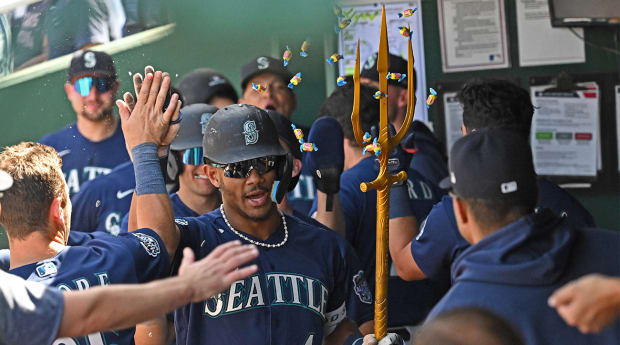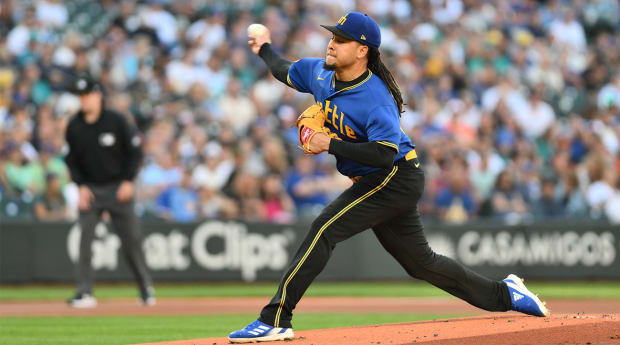To succeed as a pitcher in the big leagues, you need two of three pillars of the craft: velocity, command and deception. One is not enough—even if it’s velocity. Like the Rays, the Mariners have leaned on deception as a core principle.
Seattle is the hottest team in baseball. It suddenly has the AL West title in its sights. It trails Texas by three games with seven games left against the Rangers. The Mariners are 14–3 since Aug. 2. Their star outfielder, Julio Rodríguez, deservedly gets attention for his molten-hot streak during this run.

Peter Aiken/USA TODAY Sports
But the backbone of Seattle’s team is its starting pitching. And here’s what is so impressive about this 14–3 run: 14 of the 17 games were started by pitchers the Mariners drafted and developed. More so, they are pitchers the Mariners identified as having deception as a pillar of their arsenal.
Deception is delivering a baseball in a way that throws the balance of a hitter. It’s more than some Johnny Cueto–like funk to the delivery. It’s staying outside the normal range of what a hitter sees. Hitters make swing decisions based upon the thousands of pitches they see. It’s a way of synthesizing information called “chunking”—essentially distilling all those pitches to an expectation of where the ball typically will be. The further outside the norm a pitcher’s delivery or shape of a pitch, the more the hitter’s “chunking” process is disrupted.
Knowing this, the Mariners in particular love pitchers who throw with a low release point—with velocity—to the high part of the strike zone. That’s an extreme vertical attack angle that confuses hitters. They swing under the ball because its path is not where their brains tell them to expect it to be.
How does Seattle do it? First, consider the entire staff. Seattle has the most efficient, pound-the-zone pitching staff any team has put together in five years:
Mariners Staff Ranks
| MLB Rank | ||
|---|---|---|
Strike % |
66.6% |
1 |
First pitch strike % |
64.0% |
1 |
Most pitches ahead of count |
31.9% |
1 |
Pitches in strike zone |
51.3%* |
1 |
It all starts with the rotation. It has the lowest OPS allowed this year. It has plenty of deception.
Start with how your average MLB starter throws. Roansy Contreras of Pittsburgh is the closest proxy to how the average major league starter releases a fastball:
Four-Seam Fastball Averages
| Contreras | MLB | |
|---|---|---|
Release Height |
5.88 |
5.84 |
Release Extension |
6.7 |
6.5 |
MPH |
94.3 |
94.2 |
Batting Average |
.381 |
.261 |
Contreras has no deception. He has no edge in velocity, either. Average gets hit.

Steven Bisig/USA TODAY Sports
Now let’s look at what makes the six Seattle starters so hard to hit:
Luis Castillo (acquired in 2022 trade): The Slinger
He has the toughest four-seam fastball to hit: .159 (min. 750 fastballs). Why? No one in baseball throws that hard (96.3) from that low of a release point (5.2 feet off the ground).
Logan Gilbert (2018 first round): The Long Arm
He releases the ball 7.4 feet in front of the rubber—the most extension in MLB among starters (min. 1,500 pitches). That means his fastball needs to fly about a foot less than the average fastball.
George Kirby (2019 first round): The Strike Machine
He has impeccable fastball command for a guy who throws 62% fastballs and is so young. We’ve never seen a starter this young with this kind of a strikeout-to-walk rate:
Best SO:BB Rate Since 1900, 25 and Under (Min. 24 GS)
| All-Time Ranking | Player | Season | Rate |
|---|---|---|---|
1 |
George Kirby |
2023 |
9.50 |
2 |
Ben Sheets |
2004 |
8.25 |
3 |
Shane Bieber |
2019 |
6.48 |
4 |
Walter Johnson |
1913 |
6.39 |
Bryce Miller (2021 fourth round): Mr. Country Hardball
Miller has the highest four-seam fastball spin rate: 2,601 rpm (min. 750 fastballs). His rate of 62.1% four-seamers is the third highest in MLB (Justin Steele, Michael Kopech).
Bryan Woo (2021 sixth round): The VAA Monster
What’s VAA? Vertical attack angle.
Woo is 6'2". His release point is 4.94. When he throws his four-seamer 2.75 feet or higher, batters hit .135. That’s a vicious vertical attack angle.
Emerson Hancock (2020 first round): The Funky Fastball
Hancock is 6’4”. His release point is 5.4. It’s a funky pitch because his four-seamer pops out from the side of his hand, rather than the traditional way of throwing it with a flat wrist completely behind the ball. The Mariners have identified pitching outliers whose stuff plays up. If you mapped out their release points, they stay out of that dangerous area of average:
Four-Seam Release Height (Starting Pitchers, 1,000 Pitches)
Logan Gilbert |
6.21 |
George Kirby |
5.91 |
MLB Average |
5.84 |
Bryce Miller |
5.76 |
Emerson Hancock |
5.40 |
Luis Castillo |
5.20 |
Bryan Woo |
4.94 |
Here’s why Seattle is a dangerous team now and in a postseason scenario: It gets hitters out in the strike zone with some combination of velocity, command and deception—if not all three. It’s been an intentional buildup by Seattle as it embraced technology to understand pitch-mapping and strategizing. At a time when fastballs have reached an all-time low, the Mariners are proving a well-located fastball—especially with velocity and thrown from abnormal angles—is still the best pitch in baseball.
Mariners’ Fastball Usage (Not Including Cutters)
| MLB Rank | ||
|---|---|---|
Batting Average |
.241 |
1 |
Slugging |
.397 |
1 |
Vertical Release |
5.51 |
2 |
Percentage |
52.4% |
3 |
Height of Pitch |
2.77 |
4 |







